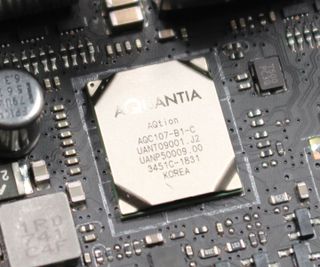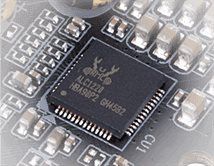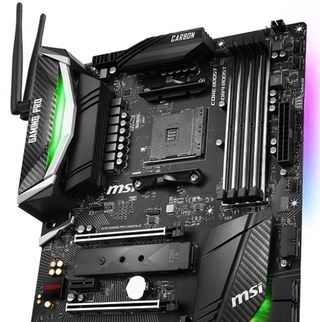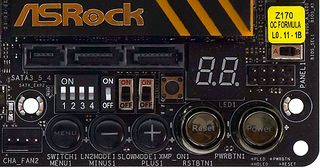8 Motherboard Features You Probably Don’t Need

From eye-catching packaging and RGB LEDs to dozens of ports and slots to a long list of ports, slots, and features, motherboard makers will throw in everything but the kitchen sink in order to upsell you to a more expensive product. While almost everyone needs a few USB connectors, there are far fewer users who plan to use 10 different SATA drives or three different Ethernet connections.
Here are several common motherboard features, in no particular order, you can (probably) do without.
1. More than 6 SATA ports

Why you wouldn’t need it: It’s always good to have the flexibility to add more storage drives, but you also need to ask yourself “how many drives am I going to have at once?” With 6 SATA lanes, you can either fit six SATA SSDs, though you’ll likely deduct at least two of those for each NVMe SSD you install. So even with two NVMe drives, you probably have two SATA drives for a total of four.
Why you would: If you’re building a server or you’re designing workstation that needs to hold giant media files, you might actually want more than four to six drives. Just make sure your case has the room to hold them.
2. 2.5Gb or 10Gb Ethernet ports

Why you wouldn’t need it: The standard 1Gb port that even budget boards have is more than 10 times faster than most home broadband connections so you only need a faster port if you plan to copy files across your local network. And remember that the other systems or NAS drives and routers you’re exchanging data with would also need a fast Ethernet port.
Why you would: If you are working with a lot of large files and backing them up on the network, you’ll appreciate the added speed. The old-fashioned Gigabit Ethernet port copies files at a rate of 125 MBps at best, far short of the speeds you get when backing up to an external SSD.
3. More than One Ethernet Port

Why you wouldn’t need it: While failures can and will happen to anything, it isn’t common enough to warrant a need for two ethernet ports. If it does happen, there are plenty of inexpensive solutions out there such as USB Wi-Fi dongles or PCIe network cards. Often times, motherboards have integrated Wi-Fi already and users are able to fail over to the Wi-Fi if needed. As far as bandwidth goes, most homes have around 100 Mbps links (or less) anyway, so the likelihood to need it for teaming is not common at home.
Stay on the Cutting Edge
Join the experts who read Tom's Hardware for the inside track on enthusiast PC tech news — and have for over 25 years. We'll send breaking news and in-depth reviews of CPUs, GPUs, AI, maker hardware and more straight to your inbox.
Why you would: Some motherboards with dual ethernet ports support NIC teaming. Teaming is the art of combining two or more physical Ethernet links into a single link. In other words, if you combine two 1 GB/s ports, its aggregated bandwidth would be 2 GB/s. It can also provide link resiliency, though you would lose the aggregated bandwidth in the case of a failure. Even if you are not teaming, the second port can be used for failover anyway. This would also help with improved bandwidth across your home LAN if one is set up.
4. USB 3.1 Gen 2 (10 Gbps)

Why you wouldn’t need it: USB ports generationally are getting faster and faster with the latest USB 3.1 Generation 2 ports reaching 10 Gbps (~1,250 MBps). This compares to USB 3.1 Generation 1 at 5 Gbps (~625 MBps). The only devices which can use that type of bandwidth through USB are external devices, particularly USB connected storage. The fastest USB sticks can reach around 400 MBps and USB DACs do not require a lot of bandwidth either. There are few reasons it is a need.
Why you need it: We are just now seeing the ultra-fast NVMe drives come in an external enclosure connecting to the PC via USB-C. Many of these drives could saturate a Gen1 controller. Some external drive enclosures could eclipse the 5 Gbps mark as well, especially with SSDs in RAID with striping.
5. Realtek ALC1220 CODEC (Premium integrated audio)

Why you wouldn’t need it: Integrated audio on the PC has come a long way over the last decade. Back in the day, it was almost a second thought to motherboard vendors. Today, we have seen notable improvements to the point where many users would be hard pressed to hear differences between this premium codec and one that's a step-down. To hear these differences, users would need a discerning ear as well as a good set of speakers or headphones.
Why you would need it: Some users purchase higher end speakers and headphones (Sennheiser perhaps) which are able to get the most out of the premium codec. Outside of that, it becomes difficult to actually hear any differences. $30 Turtle Beach headphones at Best Buy need not apply.
6. PCIe and DRAM Slot Shielding

Why you wouldn’t need it: For the most part, a PC is a static object that doesn’t get moved around a lot. And while there are some pretty heavy triple slot video cards out there, so long as they are properly mounted and screwed into the expansion slot area, it really isn’t needed. As far as memory slot shielding, even with the largest heat sinks on them, memory is not heavy.
Why you would need it: Let’s be honest, a little extra support can’t hurt, right? On a more serious note, some users take their PCs with them for LAN parties or to a friend’s house where some jostling and movement occurs. If you have a heavy video card, that can put a lot of stress on the slot.
7. Slow Mode / LN2 Mode

Why you wouldn’t need it: Extreme overclocking, defined (to me) as using sub-ambient cooling methods when pushing an overclock, use some pretty cool techniques in order to get the PC to boot at such high speeds. A slow mode is used for booting up at a slower speed to prevent freezing upon boot while LN2 modes typically (what they do exactly will vary by board partner) disable power limits, and set up the system for LN2 (Liquid Nitrogen) type cooling. Even under an overkill water cooling system, these features will not help with that type of overclocking.
Why you need it: Only those who use sub-ambient cooling methods should look for motherboards with these features.
8. Onboard Video Ports

Why you wouldn’t need it: Unless you are building the cheapest of budget PCs, you are probably using a discrete video card that has its own ports. Some Intel and AMD CPUs do not even have integrated graphics. If there isn’t any integrated GPU on the CPU, the ports do nothing but take up precious space on the rear IO.
Why you would need it: No part is immune to failure and your discrete GPU does fall into that category. If the discrete GPU fails, the only way to get an image on your screen is through buying another video card (or maybe another is laying around). If your CPU happens to have an integrated GPU, you can get the system up and running while using the onboard.
Bottom Line
When shopping for a motherboard, it's always tempting to go for the one with the longest list of features. But every dollar or pound counts when you're budgeting for a PC so it only makes sense to ask yourself some tough questions.
Do you really need 1.73 Gbps Wi-Fi, 2.5/10 Gbps Ethernet, LN2 modes, or more than six SATA ports? For many, that answer is no and thankfully motherboard vendors offer plenty of options without some of these cost-increasing features. Most users only have a couple of HDDs/SSDs, one video card, a single Gigabit Ethernet connection, and if they overclock, it is using ambient cooling methods.

Joe Shields is a Freelance writer for Tom’s Hardware US. He reviews motherboards.
Most Popular


